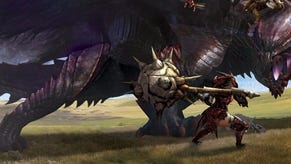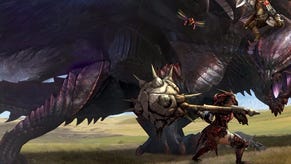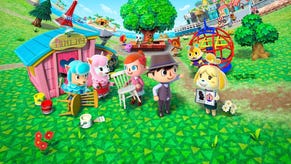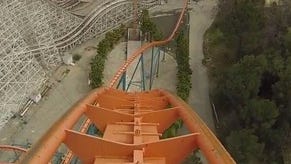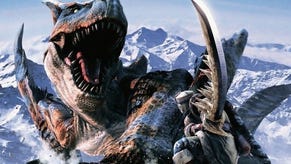How Monster Hunter 4 switches up the formula
Monsters brawl.
How exactly do you improve upon Monster Hunter? The series represents so many cornerstones in everything from the weapon classes, quest structure and crafting system, that from game-to-game, the most apparent changes are less fundamental and more supplementary. The addition of new monsters, subspecies and equipment has always been the easiest way to please the hardcore fanbase, but while the introduction of underwater combat in Monster Hunter Tri was a solid attempt at offering a twist on a familiar concept, it was hard not to feel a sense of déjà vu after setting a shock trap and hurling a couple of tranquiliser bombs.
In many ways, this dedication to the established framework has turned Monster Hunter from a PlayStation 2 era curio to one of the most finely crafted co-op experiences in gaming. It's no wonder the series sells so well in its native Japan, as each instalment strikes an increasingly honed balance between dynamic teamwork, satisfyingly weighted combat and challenging AI. But when Capcom announced that Monster Hunter 4 was coming exclusively to the 3DS, it made us believe that Monster Hunter was going to change.

After racking up around 20 hours on the recently released Japanese version, it's fair to say that Capcom has backed up its words - at least for the most part. One of the more noticeable changes is the expanded story. The single player campaigns often felt like more of an afterthought but now the story takes place across four villages as you travel with a caravanning crew of nomadic hunters. The language barrier makes it difficult to gauge whether the story holds any merit, but the amount of time I spent hammering the A button in front of a wide range of characters suggests that there's at least plenty to it.
One criticism that was levelled at Monster Hunter Tri and Monster Hunter 3 Ultimate was that there wasn't enough monster variation. There were lots of dragon wannabes and brute wyverns but not a whole lot in-between. Monster Hunter 4 addresses this shortcoming by reinstating some of the more outlandish creatures from the past games - including the gorilla-like Congalala from Monster Hunter Freedom Unite and the thunder crunching Khezu from the original - in addition to a generous selection of new monstrosities.
Many of these beasts take inspiration from the less explored avenues of wildlife. The Garara Ajara, for instance, is a snake-like creature that can fling explosive scales from its tail, and should it manage to encircle you with its slithering body, it'll catch you in a constricting attack for serious damage. If snakeskin boots aren't your thing, though, then the shark-like Zaboazagiru offers a challenge that's equally inventive. When it burrows underground like a Nibelsnarf, you can use a sonic bomb to force it to surface, and then once it's enraged, it'll coat itself in ice armour like a Glacial Agnaktor.
That isn't it for the party tricks, either, as the Zaboazagiru can suck in air like a puffer fish before making like a titanic bowling ball. It's an easy attack to avoid and yet it sticks in the mind because the animation is particularly impressive for a handheld. It's also clear that this game has been tailor made for the 3DS right from the start. None of the hunting grounds have been recycled and everything looks noticeably crisper. But more than anything else, the maps in Monster Hunter 4 have a verticality that's completely at odds with the comparatively flat landscapes of the previous games.
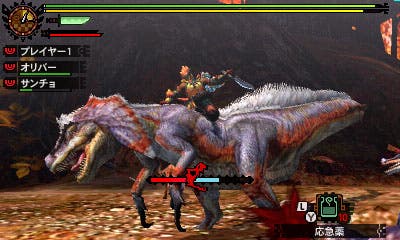
It's almost like comparing Australia to Switzerland as each map is littered with climbable surfaces that range from sheer cliff faces and steep pillars to thick stalactites and suspended spider webs. The effect this layered design has on the hunting is that you can now lure a monster to an elevated point before literally jumping on them. This works by striking the monster in mid-air as you hurtle towards them, and if your strike hits the mark and the conditions are just right (presumably their stamina being low enough), you'll activate a quick mini-game.
While the monster is thrashing about, you have to hold the right bumper to steady your grip, and then the instant they tire, you have to repeatedly stab them with your carving knife by mashing the attack button. If successful, you'll knock the monster over and gain a few precious seconds to hit it with everything you have. This doesn't mean you can hitch a ride on a Rathalos before striking it down mid-flight, unfortunately, but it succeeds in adding an extra dimension to an already sophisticated combat system. The same is also true of the new weapon classes.
The Charge Axe is similar to the Switch Axe in the sense that it can morph between two different forms. When in Sword and Shield mode, you can perform a basic three hit combo in addition to a more powerful charge attack, and then once you switch to Axe mode, you lose the ability to block but your attacks strike with more force and greater range. The twist is that each sword hit charges the phial gauge. The idea is then to max out the phials before unleashing a special Axe attack that does heavy explosive or elemental damage.
"Capcom has made more meaningful changes while retaining the core fundamentals that make the series so utterly compelling in the first place."
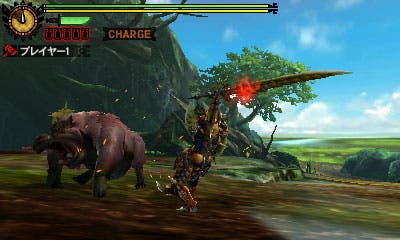
Despite offering an interesting fusion of play-styles, the Charge Axe is unlikely to usurp the popularity of the Long Sword or Switch Axe. It just doesn't feel as fresh or as flashy. The Insect Staff, on the other hand, is much less derivative. It functions similarly to the Long Sword in the sense that you can chain attacks together at a respectable pace and it also has the advantage of inflicting both slash and impact damage. More interesting still, you can use the staff to fire a projectile packed with insect pheromones before commanding your arm-mounted bug to attack whichever part of the monster you hit.
Things get even more tactical when you start using your friendly bug to drain different enhancements. These can relate to attack, speed, defence and health, and by calling the bug back to your arm, you can absorb and even stack the various buffs together. The Insect Staff also has a more involved upgrading system, as in addition to improving the staff itself, you can evolve the bug into a wide range of beetles, butterflies and moths - each with its own set of stats. Oh, and you can also use the staff to pole-vault into the air for an easy mount attempt.
In addition to the more obvious changes, Monster Hunter 4 tightens things up in other area. The most important change, by far, is that the words "Packet Relay Tool" have been entirely abolished. If you want to team up with other Blade Masters and Gunners online then all you need is an internet connection, a Wi-Fi router, a 3DS and a copy of the game - rejoice. The game also side-lines Cha Cha and Kayamba in favour of the Felyne Comrades, and much like Monster Hunter Portable 3rd, you can craft armour and weapons for these cat-like minions.
Having only just scraped the surface of the guild quests, there's still a lot about Monster Hunter 4 that I haven't experienced. I've not jumped on the back of a Savage Deviljho, I don't know how the armour skills have changed and I'm still a long way off the new Kirin subspecies and the end-game Dara Amadyura. Even so, it's clear that Capcom has made more meaningful changes while retaining the core fundamentals that make the series so utterly compelling in the first place. Some might wish the changes were more dramatic, of course, but there's no denying that this game deserves a western release, and the sooner the better.


